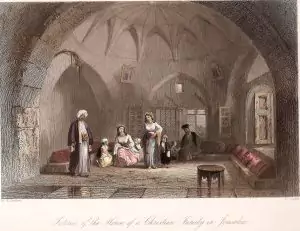 Christianity is the most popular religion in the world, but it started from a humble beginning. With a Jewish man named Jesus of Nazareth at its head, Christianity was at first a small collection of Jewish people looking for blessings and knowledge from their savior. Eventually, at its present state, there are around 20 major denominations of Christianity, and perhaps thousands of sects of this religion. What caused this growth and how did the history of this religion unfold? The answers to these questions will be elaborated on in the following paragraphs.
Christianity is the most popular religion in the world, but it started from a humble beginning. With a Jewish man named Jesus of Nazareth at its head, Christianity was at first a small collection of Jewish people looking for blessings and knowledge from their savior. Eventually, at its present state, there are around 20 major denominations of Christianity, and perhaps thousands of sects of this religion. What caused this growth and how did the history of this religion unfold? The answers to these questions will be elaborated on in the following paragraphs.

✅ AI Essay Writer ✅ AI Detector ✅ Plagchecker ✅ Paraphraser
✅ Summarizer ✅ Citation Generator
The start of Christianity naturally begins with the Jewish Christians. At this time, it was a movement of people following Jesus of Nazareth, and not referred to as Christianity. These people accepted Jesus as the Jewish messiah. The only difference between these individuals and regular Jewish people was this acceptance. Jesus was in fact one of many Jewish messiahs of the time, and was not even the most well-known among them. He was mostly understood at first as a torchbearer for John the Baptist. When John the Baptist died, many of his followers joined Jesus’ group. Once again, it is important to note that all of this was from a Jewish perspective and within Jewish culture alone (Freedman, David Noel, et al).
Furthermore, the beginning of Christianity can be said to be divided into two eras: the apostolic period and the post-apostolic period. There were 12 main apostles of Jesus and perhaps hundreds of followers at the time of his death and resurrection. Apostles were said to be responsible for spreading Jesus’ teachings and were to act in Jesus’ place, whereas followers were not given this right. However, when Jesus resurrected, he gave his Great Commission, and commanded all of his followers to have his teachings spread across the world and to baptize everyone (New Testament).
Though Jesus’ last message was positive and all-encompassing, it caused confusion in his congregation when converting people of non-Jewish origin. In the earliest accounts of conversion among the Gentiles, it was not certain if they should be Jewish converts or labeled strictly as followers of Jesus. The issues of circumcision and dietary laws common to Jewish people were sometimes waived when Gentiles were converted.
Around 50 AD, there was a Council of Jerusalem—about 15 to 25 years after Jesus’ crucifixion. The gathering was held to decide if non-Jewish converts to the following had to be circumcised in order to be “saved” (“JewishEncyclopedia.com”). However, other issues eventually got discussed, such as the need for converts to follow the Torah and Jewish dietary habits. What was finally agreed upon is that this Jesus’ following should not be difficult to enter, and that circumcision and other factors of Jewish faith were not to be strictly implicated. At this time, there were already several congregations of Jesus’ followers.
As the influence of the apostles spread, Jewish authorities began to retaliate. Many apostles and followers of Jesus started to be not welcome in synagogues. But in Hellenistic Greece, the divide between the followers of Jesus and regular Jewish people was not so apparent. In fact, followers of Jesus worshiped in synagogues for centuries after Jesus’ crucifixion (Nicklas, Tobias).
The term “Christian” came from a city in Greece named Antioch—now in the country of Turkey. It is where Peter resided as the first bishop of Christianity, founding a church there. The locals of the region began to call the followers of the church “Christians” to mean something like “little Christs” (Vonier, Anscar). From this founding of the church and them being called “Christians” the divide between Judaists and the followers of Jesus became more prominent.
Starting as a strictly Jewish movement based on the messiah Jesus of Nazareth, after the death of its leader, it gradually transformed into its own religion separate from Judaism. Through the conversion of non-Jewish people and the building of the first Christian churches, the religion began to be more and more distinct from its Torah-based belief and culture.
Works Cited
Freedman, David Noel, et al. Eerdmans Dictionary of the Bible. William B. Eerdmans Publishing Company, 2009.
New Testament. NTC Pub. Group, 1996.
“JewishEncyclopedia.com.” CIRCUMCISION – JewishEncyclopedia.com, jewishencyclopedia.com/articles/4391-circumcision#2.
Nicklas, Tobias. Jews and Christians?: Second-Century “Christian” Perspectives on the “Parting of the Ways” ; (Annual Deichmann Lectures 2013). Mohr Siebeck, 2014.
Vonier, Anscar. Christianus: the Christian Life. Zaccheus Press, 2011.
Follow us on Reddit for more insights and updates.





Comments (0)
Welcome to A*Help comments!
We’re all about debate and discussion at A*Help.
We value the diverse opinions of users, so you may find points of view that you don’t agree with. And that’s cool. However, there are certain things we’re not OK with: attempts to manipulate our data in any way, for example, or the posting of discriminative, offensive, hateful, or disparaging material.